Saturday, May 28, 2005
The madness must be stopped!!!
Tuesday, May 24, 2005
Dear Boston Globe:
Friday, May 20, 2005
If I had a million dollars. . .
Update: (5/22/05) It just ocurred to me that even if some fairy godmother were to bestow $1 mil. on me, I still could not afford this place, because there would still have to be a mortgage for $449,000. The Globe did a huge write-up of the property and the real estate situation in Eastie on the front page of this week's Sunday real estate section. Here's the gist of it:
On one side, 60 Marion is a stalwart row house, a fixer-upper with a small yard, oak kitchen cabinets, and a low price tag: $299,999. On the other, 64 Marion is a renovated firehouse; a loft-style ''smart home" where your digital music collection can be voice-activated from the steam shower. With an asking price of $1,449,000, the loft may well be among the most expensive residential properties in East Boston history. . .
In this tale of two houses, these side-by-side properties represent an even larger story within East Boston's turbulent real estate market. It's a neighborhood in the infancy of gentrification, where an immigrant, blue-collar community brushes shoulders with a trendy, more affluent crowd. It's luxury condominiums mingling with tumbledown three-deckers as merging communities carve out identities in a changing neighborhood. . .
Most of East Boston is still affordable right now, but the firehouse loft could prove to be its tipping point, as more upscale housing in the pipeline promises similar price tags. . .
''East Boston right now reminds me of Charlestown in the late 1980s," said Sherry A. Grancey, principal of Grancey & Company Real Estate in Charlestown. ''The same kind of people who left the Back Bay for Charlestown in the 1970s and 1980s are flocking to East Boston with that same pioneering spirit."
Lord, help us all. What I want to know is where are all the poor people supposed to live when Eastie becomes EaBo?
Thursday, May 19, 2005
10 Things I love about East Boston
#4 Cafe Italia
The best cappuccino in Boston. That's right! I said best. Even better than in the North End. Cafe Italia has a little something for everyone: good quality, up-market Italian food including pizza; a lounge with a full bar; and, of course, the cafe. The cappuccinos in the cafe are made with good Italian coffee. What I mean by good is that the coffee is strong, but it doesn't taste burnt. The foam--and I do mean foam not that anemic stuff Starbucks tries to pass off as foam--is so thick you might get a foam mustache. If you add sugar, it will sit up on top until you stir it in. This combination is served in a small cup, not the big gulp sized cups that Starbucks serve their "caps" in. In a cup that big, your little shot of espresso doesn't stand a chance of holding up to the milk. At Cafe Italia, you can actually taste the coffee in your cappuccino. Finally, the Cafe Italia cappuccino is topped off by a generous dusting of cocoa. Have you never had a cappuccino outside of Starbucks? Well, then get thee to Cafe Italia to find out what the real thing is supposed to taste like. Oh, and the pastry and gelato aren't half bad either.Sunday, May 15, 2005
New Photos.
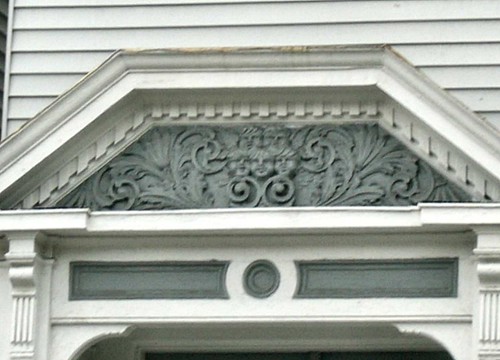
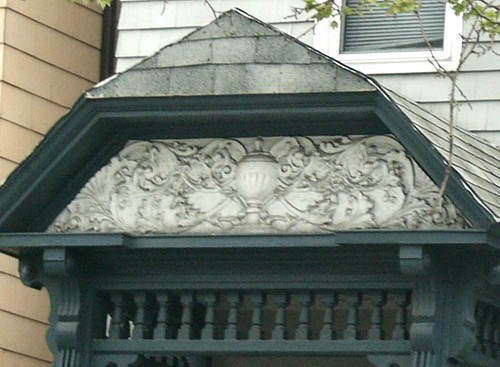
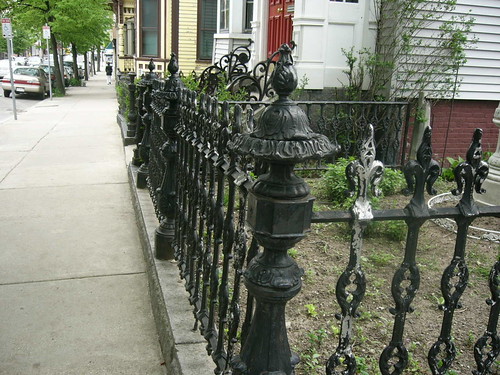
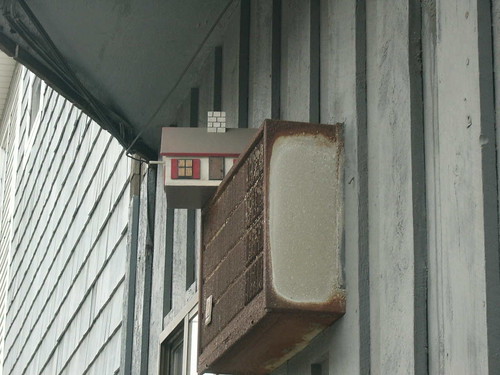
I think it must have been a hopeful soul.
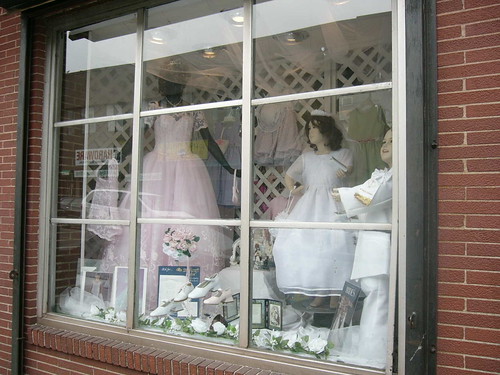
hard to tell from this photo, but the skirt of the pink dress is
all lace. The mannequin is also wearing a tiara.
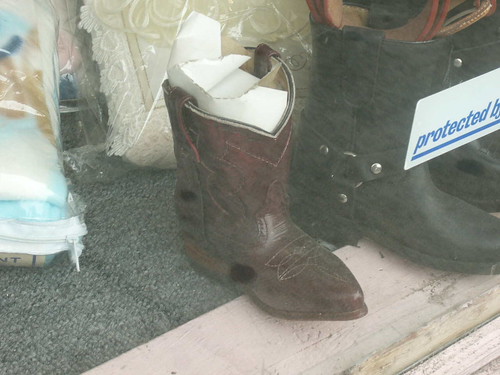
Street. I just wish the window wasn't so dang dirty. Too cute!
Friday, May 13, 2005
Swanky!
Today, bulldozers are turning Maverick Gardens [Housing Project] into mounds of brick, rubble, and shredded ironwork. Most of the residents have moved across the street to the new Maverick Landing, which offers apartments in a colorful townhouse-style building, individual backyards, plus some spectacular views of the downtown skyline that lies across the harbor. While Maverick Gardens was limited to the poor, Maverick Landing is a mixedincome development, with 20 percent of the units set aside for renters who will pay market rates to the private developer that built the project. The Boston Housing Authority remains nominally in charge, but it leaves day-to-day management to a partnership between the developer and a tenants' association. In 15 years, the association will have the right to buy the buildings from the developer; in the meantime, residents can apply for federal subsidies that would allow them to buy their individual units.I'm not sure how many people from Maverick Gardens have moved into the new development, but I wonder if his statement that "most of the residents have moved across the street to the new Maverick Landing" may perhaps be an overstatement. The building of this project has been over several years so lots of people have had to move out of sections of Maverick Gardens long before the new buildings were ever built. Former residents of Maverick Gardens have first priority for housing at Maverick Landings, but I wonder how many of the original MG tenants have returned. I know one thing. I can't afford the market rate units.If this sounds like a conservative's idea of what public housing should look like, that's because it is. New Maverick is a product of the Hope VI federal housing program, an initiative whose intellectual lineage traces back, in part, to Jack Kemp, the former Republican vice presidential candidate who was secretary of housing and urban development under President George H.W. Bush. Kemp believed the way to save public housing was to make residents more responsible for their own communities by giving them incentives to take control and offering them a financial stake in the projects' success. And that's exactly what Hope VI does: Rather than having government do the heavy lifting of razing old projects and building new ones, Washington merely puts up seed money. It's up to the tenants of the old projects, working with local housing authorities, to apply for that money. They can't get it until they've lined up a private developer and put together a convincing plan for managing resident services like security or after-school activities. Hope VI flourished under the Clinton administration--which, despite its liberal reputation, was no fan of old-style public housing. And today, its most ardent defenders include Republicans like Senator Kit Bond, who believes the program has done wonders in his home state of Missouri.
But guess which very important Republican doesn't like the program? Bush. His proposed budgets have tried to eliminate the program for two years running. Although Congress hasn't let him do that yet, he has already pushed down funding to a mere quarter of what it was at the height of the Clinton administration's investment.
Related story: Maverick Gardens
Tuesday, May 10, 2005
I'm not sure what the T is trying to say about their service
Monday, May 02, 2005
10 Things I love about East Boston.
#3 Riding the bus is always an adventure.
True story. Picture the scene. The back of your typical MBTA bus. There you will find me and my two Somerville friends, 3 Latino guys, 2 white girls with attitude, and a guy with a boom box. (The boom box is playing, but not “booming.”) Latino guys have a brown paper bag which they find hilarious for some inexplicable reason. Suddenly, one of the guys rustles around in the bag and pulls something out and puts it on the floor. Somerville friends and I try to ignore, but let’s face it, with the peals of laughter, it’s a scene. I spot the thing that the guy has put on the floor of bus and dear Lord it’s moving—crawling in fact, towards Somerville friend’s foot. But what the hell is it? Then my brain finally registers the shape. It’s a crab!. A tiny, black crab about the size of a quarter. About the same time that I realize it’s a crab everyone else sees it and there is not just one. Latino guys are playing with two more on their laps. The problem is that one white girl with attitude—we’ll just call here WGWA, doesn’t like crabs and commences freaking out. This of course only increases the hilarity for Latino guys. At this point WGWA begins screaming obsenities at Latino guys. “Get that f-cking thing away from me! If that f-cking thing touches me, I’m going to kick your ass! Then we’ll see what the f-ck is so f-cking funny, you f-cking a-holes.” Then the guy with the boom box decides that he needs to get in on the act. “You better watch out.” he warns WGWA. “You don’t want to catch his crabs. He, he, he.” Now repeat scene for seven more bus stops. Quoth Somerville friend, “I love this bus!"
| PS. I still have no idea what the crabs were for. I'm guessing they were for bait. I do see people fishing in the Chelsea Creek quite often. I wonder how many three-eyed fish they pull out? |  |









